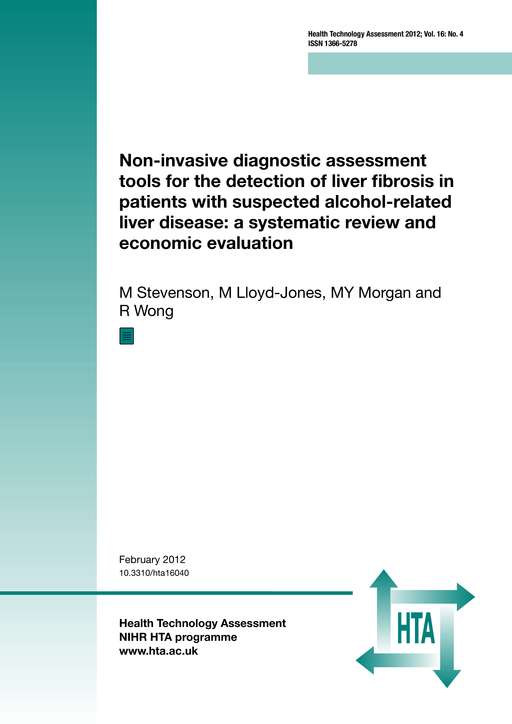Non-invasive diagnostic assessment tools for the detection of liver fibrosis in patients with suspected alcohol-related liver disease: a systematic review and economic evaluation.
Health technology assessment (Winchester, England)
Stevenson M, Lloyd-Jones M, Morgan MY, Wong R
2012 Health Technol Assess Volume 16 Issue 4
PubMed 22333291 DOI 10.3310/hta16040
BACKGROUND
Excessive alcohol consumption may lead to the development of alcohol-related liver disease (ALD). Liver biopsy may be used in patients with suspected ALD to confirm the diagnosis, exclude other or additional liver pathologies, and provide accurate staging of the degree of liver injury in order to enable the prediction of prognosis and inform treatment decisions. However, as it is an invasive procedure that carries the risk of morbidity and mortality, current UK guidance recommends that biopsy is not required to confirm the diagnosis in patients with a high clinical suspicion of ALD in whom blood tests have excluded other causes of liver disease, unless it is necessary to confirm a diagnosis of acute alcoholic hepatitis in order to inform specific treatment decisions.
OBJECTIVES
To evaluate the diagnostic accuracy, cost-effectiveness, and effect on patient outcomes of four non-invasive tests for liver fibrosis [the Enhanced Liver Fibrosis (ELF™) test (Siemens Healthcare Diagnostic Inc., Tarrytown, NY, USA), FibroTest (BioPredictive, Paris, France), FibroMAX (BioPredictive, Paris, France) and transient elastography (FibroScan(®); produced by EchoSens, Paris, France and distributed in the UK by Artemis Medical Ltd, Kent, UK)] in patients suspected of having ALD.
DATA SOURCES
A systematic review was undertaken to identify studies reporting the diagnostic and prognostic accuracy of the ELF test, FibroTest, FibroMAX, and FibroScan for the identification of liver fibrosis and associated conditions in patients with suspected ALD. The following databases were searched in January 2010: MEDLINE (from 1950 to January 2010), MEDLINE In-Process & Other Non-Indexed Citations (from 1950 to January 2010), EMBASE (from 1980 to January 2010), Cochrane Database of Systematic Reviews (from 1996 to January 2010), Cochrane Central Register of Controlled Trials (from 1898 to January 2010), Cochrane Methodology Register (from 1904 to January 2010), Database of Abstracts of Reviews of Effects (from 1995 to January 2010), HTA Database (from 1995 to January 2010), NHS Economic Evaluation Database (from 1995 to January 2010), Cumulative Index to Nursing and Allied Health Literature (from 1982 to January 2010), Web of Knowledge and Science Citation Index (from 1969 to January 2010).
REVIEW METHODS
Study quality was assessed using the QUADAS (Quality Assessment of Diagnostic Accuracy Studies) checklist. Owing to the heterogeneity of the studies, no formal meta-analysis was undertaken. A de novo mathematical model was constructed to estimate the incremental costs and incremental quality-adjusted life-years (QALYs) associated with alternative strategies compared with a biopsy-all strategy. The tests are assessed first as a replacement for liver biopsy, and secondly as an additional test prior to liver biopsy. Thirty-six scenarios were assessed for each non-invasive test strategy, which varied the sensitivity of biopsy, the anxiety associated with biopsy, sensitivity and specificity values and whether or not the biopsy was percutaneous or transjugular. For each scenario, threshold levels were reported where biopsying all patients was more cost-effective than the strategy for two parameters (the decreased level of abstinence associated with the strategy compared with biopsying all and the level of incidental QALY gain associated with biopsy).
RESULTS
No studies were identified that specifically assessed the ELF test, although a study was identified that evaluated the diagnostic accuracy of the European Liver Fibrosis Test (essentially, the ELF test with the addition of age to the algorithm) compared with biopsy. Three studies of FibroTest, no relevant studies of FibroMax, and six studies of FibroScan assessing accuracy compared with biopsy in patients with known or suspected alcohol-related liver disease were identified. In all studies, the number of patients with suspected ALD was small, meaning that the estimated sensitivities and specificities were not robust. No conclusive estimate of the cost per QALY of each non-invasive test could be provided. Scenarios exist in which each of the strategies analysed is more cost-effective than biopsying all patients and, in contrast, scenarios exist in which each strategy is less cost-effective than biopsying all patients.
LIMITATIONS
Study selection and data analysis were undertaken by one reviewer.
CONCLUSIONS
No conclusive result can be provided on the most cost-effective strategy until further data are available. A large number of parameters require data; however, the following are selected as being of most importance: (1) the sensitivity and specificity of each non-invasive liver test (NILT) against biopsy at validated and pre-selected cut-off thresholds; (2) the influence of potential confounding variables such as current drinking behaviour and the degree of hepatic inflammation on the performance of NILTs; and (3) the likelihood, and magnitude, of decreases in abstinence rates associated with a diagnosis of significant ALD by diagnostic modality and the incidental gains in QALYs that may be associated with biopsy.
FUNDING
The National Institute for Health Research Technology Assessment programme.
Citation Reference:

